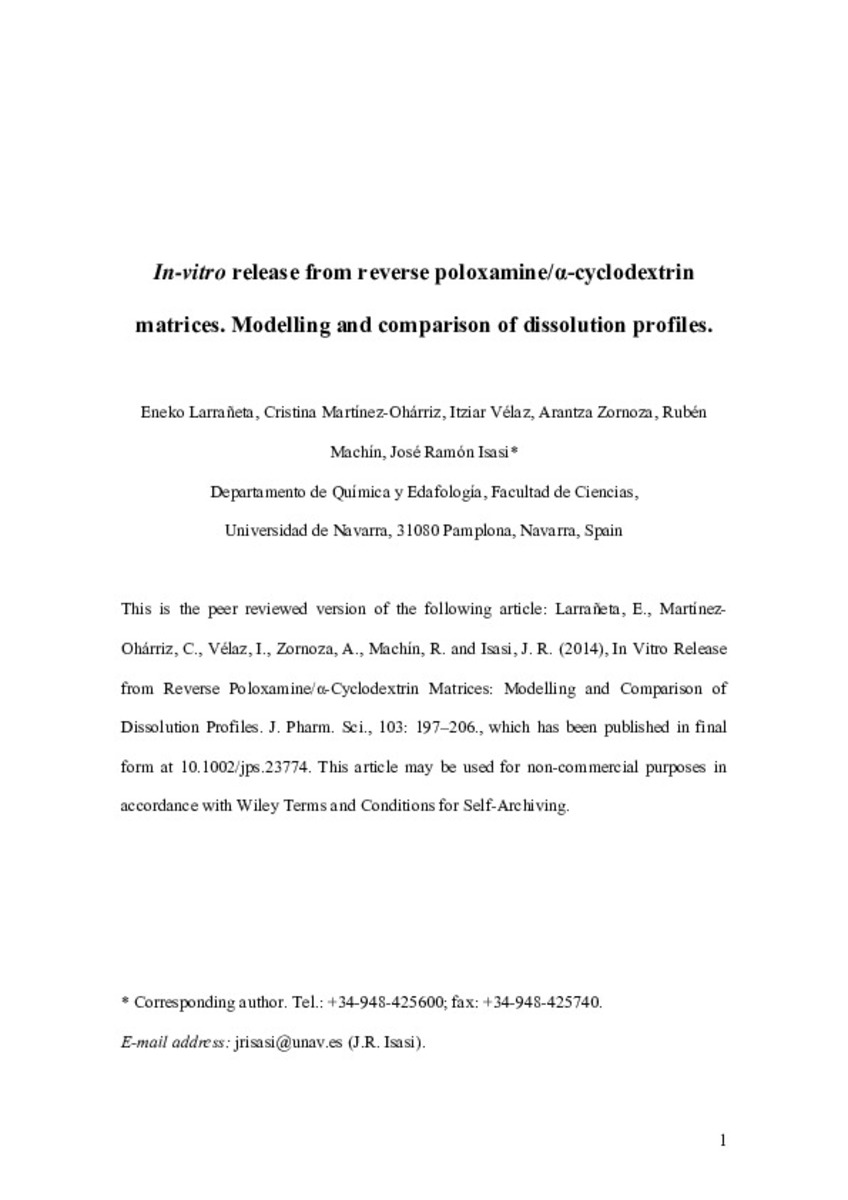Full metadata record
| DC Field | Value | Language |
|---|---|---|
| dc.creator | Isasi-Allica, J.R. (José Ramón) | - |
| dc.creator | Machin, R. (Rubén) | - |
| dc.creator | Zornoza, A. (Arantza) | - |
| dc.creator | Vélaz-Rivas, I. (Icíar) | - |
| dc.creator | Martinez-Oharriz, C. (Cristina) | - |
| dc.creator | Larrañeta, E. (Eneko) | - |
| dc.date.accessioned | 2016-03-10T11:56:54Z | - |
| dc.date.available | 2016-03-10T11:56:54Z | - |
| dc.date.issued | 2014 | - |
| dc.identifier.citation | Larrañeta E, Martínez-Ohárriz C, Vélaz I, Zornoza A, Machín R, Isasi JR. In-vitro release from reverse poloxamine/α-cyclodextrin matrices. Modelling and comparison of dissolution profiles. J Pharm Pharm Sci 2014;103(1):197–206 | es_ES |
| dc.identifier.issn | 0022-3549 | - |
| dc.identifier.uri | https://hdl.handle.net/10171/40161 | - |
| dc.description.abstract | ABSTRACT: Gels obtained by complexation of octablock star PEO/PPO copolymers (Tetronic 90R4) with α-CD were evaluated as matrices for drug release. Both molecules are biocompatible so they can be potentially applied to drug delivery systems. Two different types of matrices of Tetronic 90R4 and α-CD were evaluated: gels and tablets. These gels are capable to gelifying in-situ and show sustained erosion kinetics in aqueous media. Tablets were prepared by freeze drying and comprising the gels. Using these two different matrices the release of two model molecules, L-Tryptophan (Trp), and a protein, bovine serum albumin (BSA), was evaluated. The release profiles of these molecules from gels and tablets prove that they are suitable for sustained delivery. Mathematical models were applied to the release curves from tablets in order to elucidate the drug delivery mechanism. Good correlations were found for the fittings of the release curves to different equations. The results point that the release of Trp from different tablets is always governed by Fickian diffusion while the release of BSA is governed by a combination of diffusion and tablet erosion. | es_ES |
| dc.description.sponsorship | Ministerio de Ciencia e Innovación (project MAT2007-65752) and Universidad de Navarra (PIUNA) | es_ES |
| dc.language.iso | eng | es_ES |
| dc.publisher | Wiley | es_ES |
| dc.relation | Universidad de Navarra (PIUNA) | - |
| dc.relation | Ministerio de Ciencia e Innovación (project MAT2007-65752) | - |
| dc.rights | info:eu-repo/semantics/openAccess | es_ES |
| dc.subject | Materias Investigacion::Química::Química clínica | es_ES |
| dc.subject | Materias Investigacion::Ciencias de la vida::Bioquímica | es_ES |
| dc.subject | Controlled release | es_ES |
| dc.subject | Erosion kinetics | es_ES |
| dc.subject | Supramolecular gels | es_ES |
| dc.subject | Self-assembly | es_ES |
| dc.subject | Cyclodextrins | es_ES |
| dc.title | In-vitro release from reverse poloxamine/α-cyclodextrin matrices. Modelling and comparison of dissolution profiles | es_ES |
| dc.type | info:eu-repo/semantics/article | es_ES |
| dc.editorial.note | This is the peer reviewed version of the following article: Larrañeta E, Martínez-Ohárriz C, Vélaz I, Zornoza A, Machín R, Isasi JR. In-vitro release from reverse poloxamine/α-cyclodextrin matrices. Modelling and comparison of dissolution profiles. J Pharm Pharm Sci 2014;103(1):197–206, which has been published in final form at http://dx.doi.org/10.1002/jps.23774. This article may be used for non-commercial purposes in accordance with Wiley Terms and Conditions for Self-Archiving. | es_ES |
| dc.identifier.doi | http://dx.doi.org/10.1002/jps.23774 | es_ES |
Files in This Item:
Statistics and impact
Items in Dadun are protected by copyright, with all rights reserved, unless otherwise indicated.






